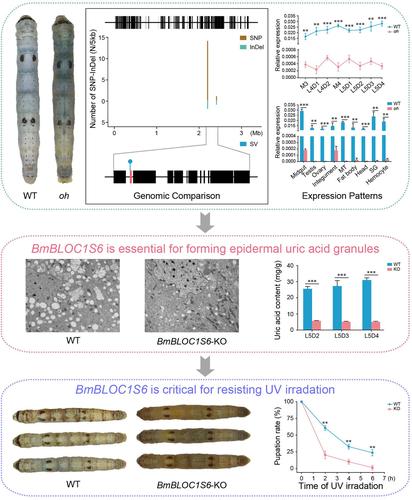当前位置:
X-MOL 学术
›
Pest Manag. Sci.
›
论文详情
Our official English website, www.x-mol.net, welcomes your
feedback! (Note: you will need to create a separate account there.)
Dysfunction of a lepidopteran conserved gene, BmBLOC1S6, causes a translucent larval integument in the silkworm, Bombyx mori
Pest Management Science ( IF 3.8 ) Pub Date : 2025-01-22 , DOI: 10.1002/ps.8664
Tao Sun, Jiangbo Song, Jingzhi Luo, Yu Jiang, Duan Tan, Lei Zhou, Wentao Wu, Minjin Han, Hai Hu, Xiaoling Tong, Cheng Lu, Fangyin Dai
Pest Management Science ( IF 3.8 ) Pub Date : 2025-01-22 , DOI: 10.1002/ps.8664
Tao Sun, Jiangbo Song, Jingzhi Luo, Yu Jiang, Duan Tan, Lei Zhou, Wentao Wu, Minjin Han, Hai Hu, Xiaoling Tong, Cheng Lu, Fangyin Dai

|
BACKGROUNDDiverse lepidopteran insects cause serious damage to plants, and their larvae possess a crucial epidermal barrier against environmental stimuli. Their ultraviolet (UV) resistance is enhanced by accumulating uric acid granules in the epidermis, suggesting that genes involved in this process may be potential targets for lepidopteran pest management.RESULTSThe silkworm pan‐genome dataset is a valuable source for studying genomic mutations and phenotype–genotype associations. Hoarfrost translucent (oh ) is a recessive silkworm mutant with a translucent larval integument. Using comparative genomic analysis, we found that the oh mutant has an 828‐bp deletion in the BmBLOC1S6 genome. BmBLOC1S6 encodes a BLOC‐1 complex subunit and is conserved during lepidopteran evolution. Knockout of BmBLOC1S6 replicated the oh phenotype. Furthermore, BmBLOC1S6 knockout and oh larvae are more sensitive to UV irradiation compared to the wild‐type. These results revealed that BmBLOC1S6 is essential in forming uric acid granules for silkworm epidermal UV resistance.CONCLUSIONOur results showed that BmBLOC1S6 is responsible for the oh phenotype in silkworms and is conserved during lepidopteran evolution. This study may help us better clarify uric acid granules formation in the epidermis, explore their function in UV resistance and identify a potential molecular target for lepidopteran pest control. © 2025 Society of Chemical Industry.
中文翻译:

鳞翅目保守基因 BmBLOC1S6 的功能障碍导致家蚕 Bombyx mori 出现半透明的幼虫外皮
背景多种鳞翅目昆虫对植物造成严重损害,它们的幼虫具有抵抗环境刺激的重要表皮屏障。通过在表皮中积累尿酸颗粒来增强它们的紫外线 (UV) 抵抗力,这表明参与这一过程的基因可能是鳞翅目害虫管理的潜在目标。结果家蚕泛基因组数据集是研究基因组突变和表型-基因型关联的宝贵来源。Hoarfrost translucent (oh) 是一种隐性蚕突变体,具有半透明的幼虫外皮。使用比较基因组分析,我们发现 oh 突变体在 BmBLOC1S6 基因组中具有 828-bp 缺失。BmBLOC1S6 编码一个 BLOC-1 复合体亚基,在鳞翅目进化过程中是保守的。敲除 BmBLOC1S6 复制了 oh 表型。此外,与野生型相比,BmBLOC1S6 敲除和 oh 幼虫对紫外线照射更敏感。这些结果表明,BmBLOC1S6 在形成蚕表皮抗紫外线的尿酸颗粒中是必不可少的。结论结果表明,BmBLOC1S6 负责家蚕的 oh 表型,并且在鳞翅目进化过程中是保守的。这项研究可能有助于我们更好地阐明表皮中尿酸颗粒的形成,探索它们在抗紫外线中的功能,并确定鳞翅目害虫防治的潜在分子靶点。© 2025 化工学会.
更新日期:2025-01-22
中文翻译:

鳞翅目保守基因 BmBLOC1S6 的功能障碍导致家蚕 Bombyx mori 出现半透明的幼虫外皮
背景多种鳞翅目昆虫对植物造成严重损害,它们的幼虫具有抵抗环境刺激的重要表皮屏障。通过在表皮中积累尿酸颗粒来增强它们的紫外线 (UV) 抵抗力,这表明参与这一过程的基因可能是鳞翅目害虫管理的潜在目标。结果家蚕泛基因组数据集是研究基因组突变和表型-基因型关联的宝贵来源。Hoarfrost translucent (oh) 是一种隐性蚕突变体,具有半透明的幼虫外皮。使用比较基因组分析,我们发现 oh 突变体在 BmBLOC1S6 基因组中具有 828-bp 缺失。BmBLOC1S6 编码一个 BLOC-1 复合体亚基,在鳞翅目进化过程中是保守的。敲除 BmBLOC1S6 复制了 oh 表型。此外,与野生型相比,BmBLOC1S6 敲除和 oh 幼虫对紫外线照射更敏感。这些结果表明,BmBLOC1S6 在形成蚕表皮抗紫外线的尿酸颗粒中是必不可少的。结论结果表明,BmBLOC1S6 负责家蚕的 oh 表型,并且在鳞翅目进化过程中是保守的。这项研究可能有助于我们更好地阐明表皮中尿酸颗粒的形成,探索它们在抗紫外线中的功能,并确定鳞翅目害虫防治的潜在分子靶点。© 2025 化工学会.































 京公网安备 11010802027423号
京公网安备 11010802027423号